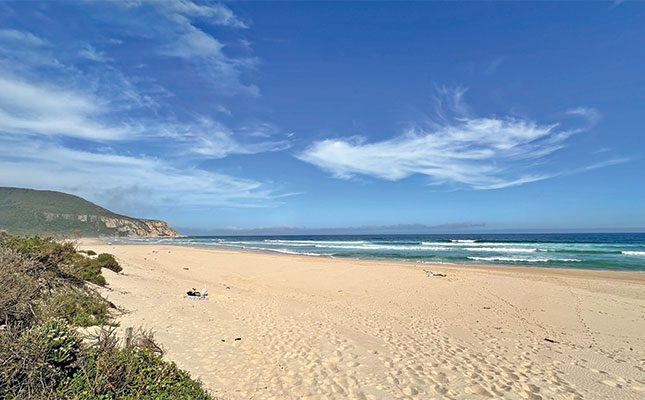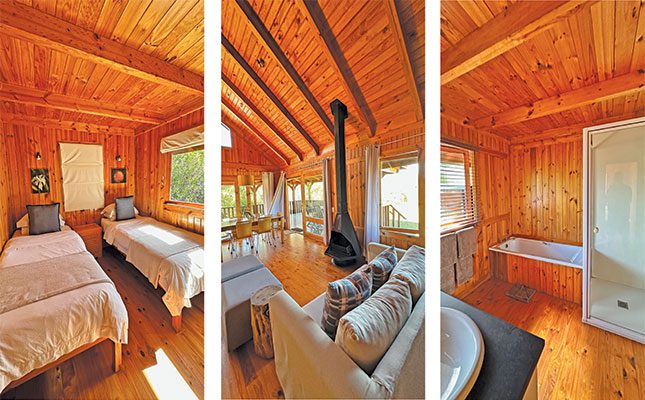Garden Route eco reserves offer plenty for bird and animal lovers
In Rondevlei, Reflections Eco-Reserve exemplifies sustainable transformation, reclaiming degraded pine forests into a haven for off-grid living and conservation.

Photo: Brian Berkman
Sometimes what might still be is more important than what is. In the case of Tim and Angelique Carr’s Reflections Eco-Reserve, which abuts the Rondevlei, what you see is only part of what may yet come.
So it is with conservation work, which is also never truer than when it is being funded and built by the Carrs themselves.
What began in 2007 as 27ha of degraded pine forests that was overgrown with alien species is already transformed. The Carrs have expanded their conservation footprint with an additional 60ha. And now have their sights on more neighbouring property with a plan to open it all to the greater nature reserve to encourage the free movement of species.
“We planted over 3 500 trees and cut these paths ourselves,” Tim Carr says while stoking the braai fire.
He told me that they had the South African family market in mind when building their carbon-neutral, two-storey timber houses. Entirely off grid, these generously proportioned houses are powered by solar, wind turbine and gas, while rain water is collected in tanks.
A double-filter system in the kitchen filters drinking water. Braai and indoor firewood are from the many alien trees cleared from the land.
Reflections Eco-Reserve shares a fence with the Garden Route National Park. There are four houses available for self-catering rentals. Each house has one queen-sized room, a second bedroom with twin beds and open mezzanine accommodation upstairs with two single beds. There is a full bathroom with a loo, as well as a separate loo and basin.
The fully equipped kitchen is well suited to self-catering. You can’t use a hairdryer or electric kettle here, but pretty much everything else can be powered and charged during your stay via renewable resources.
The generous inside spaces are also echoed outside and beyond too in the available sight-lines. The four houses are far enough away from each other to offer seclusion, yet easy enough to walk to and visit people in other houses if travelling as part of a larger group.
Each deep covered verandah has a six-seater timber dining table, a timber hanging chair that people will jostle over to use and a three-seater timber bench. A neatly cut section of lawn is around each house and outside braai area.
“We built the houses on stilts above ground level,” Carr says, adding that this keeps out the things with which one would rather not share the space.
Two glamping luxury tents are currently available and they have plans to build a new deck and lookout which will be ideal for hosted meals such as the one Farmer’s Weekly enjoyed.
Tim and Angelique met while working as guides at one of the top luxury game lodges. Tim still works as a guide, is available for hire and is a wonderful storyteller.
If you’re able to book him to explore the 140 bird species or to point out the grey duiker, Cape clawless otter, water mongoose, bush pig, caracal or grysbok found there, you will also be very enriched by the experience.
As an example of a couple who demonstrate how to live well off the grid while improving rather than degrading the environment, the Carrs really impress. Visit reflectionsreserve.com

Reflections Eco-Reserve has four self-catering timber off-the-grid houses to hire.
A view of the full bathroom at Reflections Eco Reserve.
Garden of Eden
Think of visiting the Garden of Eden on the N2 between Knysna and Plettenberg Bay as a fuel stop for your soul. This SANParks property provides a lush, cooling forest of tall Outeniqua yellowwood, stinkwood, kalander, witels and others, and is particularly special as the 1km circular route above the forest floor is entirely wheelchair friendly.
There are many places to sit along the route and picnic tables too.
Farmer’s Weekly was glad to meet Chris Patton. As content manager in the Visitor Services Unit at SANParks, his job also includes Universal Access in tourism and avitourism. He is a passionate birder too. Visit gardenrouteadventureguide.com
Nature’s Valley Trust
The Nature’s Valley Trust (NVT) is a community-driven non-profit that does excellent work in covering conservation through education, research and community involvement.
Prof Hendri Coetzee, executive director of NVT, says they have a number of projects nearby, including a nursery for indigenous plants, schools projects and a coastal project to protect the white-fronted plover and African black oystercatcher birds which nest in the dunes.
He said that understanding and changing human behaviour is one of the most important aspects of conservation and that a multifaceted approach is vital for success.
Kayla Webster, NVT Conservation Scientist in charge of their Coastal Programme, explains that coastal regions face various threats, ranging from widespread global issues such as climate change to astounding rates of human encroachment due to further development of coastal areas.
As a popular holiday destination, the Garden Route coast is continuously subjected to an increase in tourism and developments. As a result, the white-fronted plover, among other shorebirds, has experienced a reduction in numbers of up to 37% over the past three decades.
Shorebirds that nest on the ground are especially vulnerable to beach visitors as their nests, eggs and chicks often go unnoticed. Trampling and repeated disturbance (particularly by dogs) can lead to eggs or chicks not surviving.
Along the Nature’s Valley stretch of coastline, the NVT opted to follow a socio-environmental approach to shorebird breeding success by creating awareness through the provision of accurate and relevant information to the public.
“This included large billboards on beaches, leaflets, articles in local papers and a strong, positive media campaign called #ShareTheShores,” says Webster.
The primary intervention implemented by NVT was placement of nesting-area signs, sectioning off the dune area where white-fronted plover nests occur.
This ensured enough space for these skittish birds to feel safe on their nests so they could continue protecting their very temperature-sensitive eggs from the heat of the day and the cold of day break and day end.
Andrew de Blocq, BirdLife South Africa’s Avitourism programme manager, told Farmer’s Weekly that his organisation made the African oystercatcher the Bird of the Year in 2018 to celebrate its positive conservation story.
“NVT (and others) played a pivotal role in that recovery, absolutely,” said De Blocq.
“The white-fronted plover isn’t currently endangered, but the work that NVT are doing is making a big difference regardless,” he said.
Visit naturesvalleytrust.co.za Farmer’s Weekly was the guest of BirdLife South Africa, which hosts the GoBirding.co.za platform.
The Garden Route and Klein Karoo Avitourism Project was made possible by the Western Cape Department of Tourism and the Gouritz Cluster Biosphere Reserve.



